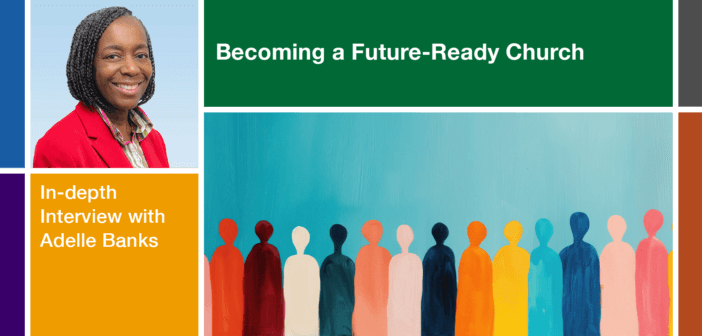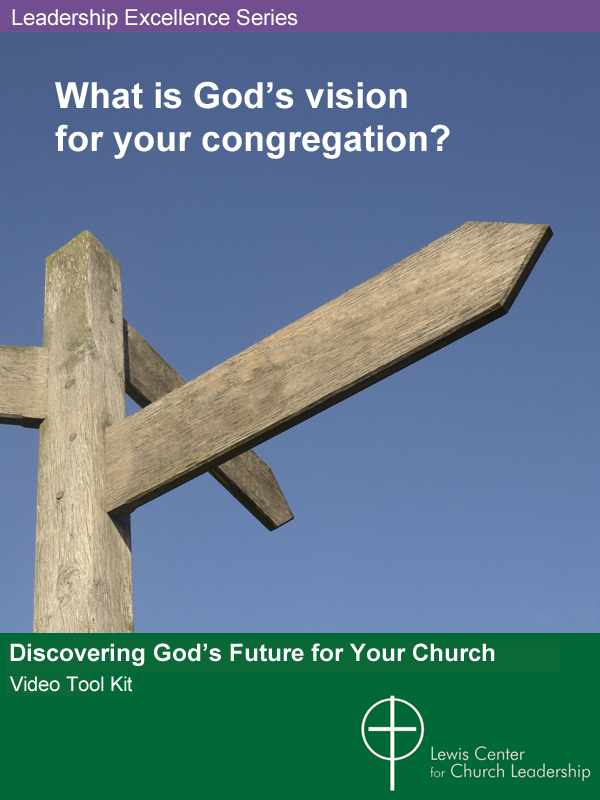What shifts are needed for congregations to be future-ready? Adelle Banks reflects on the evolving nature of church hospitality, social justice, technology, and vitality. She highlights innovative approaches that foster belonging, authentic community, and discipleship in a rapidly changing world.
Watch the interview video, listen to the interview, or continue reading.
Douglas Powe: Adelle Banks is a reporter for Religion News Service and co-author with Daniel Yang and Warren Bird of Becoming a Future-Ready Church. Share with us briefly how the three of you collaborated to write this project, and why the theme of a future-ready church.
Adelle Banks: The way we got together has to do with the whole theme of being future-ready. Warren Bird went to a conference of Exponential, a nonprofit that focuses on helping churches multiply and determine what’s next for their futures. While there, he attended a session by Daniel Yang, who was talking about shaping factors for the church in 2050. Warren heard Daniel say that there are many, many churches that are working to maintain a church model that’s shaped more like the 1950s, when they really need to be focusing on what they’re going to be like as we get closer to 2050. A light bulb went off for Warren, “Oh, that’s a really good book idea!” And so that’s the thing that people need to think about related to churches: are we closer to 1950 or 2050? So, the title refers to thinking more about the future and less about the past ways of being church.
The subtitle, “Eight Shifts to Encourage and Empower the Next Generation of Leaders,” reflects our desire to encourage people who are ministry leaders today, to work with those who are younger than them, people who are of different generations, so that they’re open to the ideas that they might have as the church moves forward. One of the biblical foundations of that idea is from 1 Samuel 17, where King Saul’s armor wasn’t right for the Bible’s young David, and he used new tools (in this case a sling) to overcome the giant Goliath. We use that as an example of why people need to start thinking about working with different generations to head towards the future.
Warren and I ended up at the same academic conference, and we knew that we were each going to be there, and being the reporter I am I said, “Oh, I’ve got some questions for you.” And Warren said, “Well, I’ve got a big question for you!” I had no idea that he had this idea about a book; and they wanted to have a reporter’s perspective who could write stories about the different shifts by talking to churches that exemplified it. And the rest is history.
Douglas Powe: It’s interesting how it came together, and I love the biblical imagery. That’s a powerful text that illuminates what you all are trying to pull off in the book. I want to jump into chapter two, where you all are talking about this shift from attendance to attachment. What does this shift mean for more traditional congregations, who are really membership focused?
Adelle Banks: When we talk about the shift from attendance to attachment, we realize that membership is something that’s harder to get your arms around these days, and relationships is more the focus that people should have. And so, we talk about a dated question being “How do we grow our membership?” and “How do we grow our attendance?” to the better question of “How do we help more people develop healthy, spiritual relationships in their complex lives?”
And so, membership is like Costco, where you have a subscription, and you’re asking people which one you’re a member of and where it’s located. And more recently, religious affiliation is much more nuanced than that. It’s more complicated for a variety of reasons, and so the focus should be more on a sense of belonging and being a place that people can have that sense of spiritual belonging as they identify who they really are. And it’s the charge of clergy to be able to say, “We’re relevant,” including to younger people, “We’re listening to you.” We realize that people need to think about a different way of approaching people coming into their churches. Making sure that they are being welcoming in lots of different ways, using the right language, and being careful to not act like it’s shameful that somebody hasn’t been in church for a while, but instead just welcome people. Be open to them.
I was listening to WHUR, the local radio station, talking about Howard University’s chapel service over the weekend. I heard the announcement that casual attire is welcome. And that’s another example of saying to people, “Come as you are. We welcome you; we want you to feel like you belong” and not have these strictures about what you should be wearing.
I interviewed a scholar named Jason Shelton for a story about his book about the contemporary Black church. And what he said may refer to all kinds of churches, but I asked him about the issue of younger people being interested in coming into a church building. And he said, a lot of it is just thinking about not having some of the same traditions, the clergy person wearing a robe, even calling the clergy person Reverend instead of by their first name, which might be an adjustment for some people. But for younger people, that’s not a big adjustment. It would probably make them feel more welcome. So those kinds of things, including having a different attitude as you’re trying to help people feel like they belong is important.
Douglas Powe: I appreciate that. I think Diana Butler Bass is the one who really uses this language and really helped all of us to think differently about this idea of belonging. The challenge is some of what you were getting to in the examples of how we get, not just church leadership (and particularly the pastor) to buy into it, but how do we get the community to really take ownership of this sense of belonging, and to really think about hospitality or welcoming in that way. So, how do we foster a better sense of belonging in the community?
Adelle Banks: One of the churches I talked to, Life.Church, said that they wanted to help people who are attending an affiliate with the church to be contributors as opposed to consumers. So, they’re not just going in and sitting and saying, “What am I going to get out of this?” It’s more, “Well, what can I do? Because I feel moved to do something now that I have this spiritual interest and involvement.” They used to have a rule where every year people signed the covenant and said, “I’m going to do this, that, and the other thing.” And now they’ve decided to have people figure out where they are themselves, what they need to do most spiritually to move to the next level. And it could be evangelism, serving in the community, or donating. And they figure that out, so that their sense of belonging fits what works for them.
Douglas Powe: You all also talk about the importance of redefining family, which I see is connected to belonging. Because churches often use this language of “We’re looking for ‘family,’–we’re looking for family.” But what you all highlight is that we’re still defining family in a traditional way; and we’re not fostering belonging. So, how do we redefine “family”? And then, how do we make the connections with the way you’re redefining it? How do we get the community to live that out?
Adelle Banks: Yeah, that’s an important question. We suggest that churches need to find ways to welcome a variety of people, not necessarily just the “nuclear” or “traditional” family, but the wide variety that’s out there. And that includes single adults, single parents, childless couples, and people who are in different kinds of circumstances. It might be interracial families, or they may have adopted kids, or have foster kids, or kids with mental health challenges. So, all those people need to be included in a church family, if churches really want to be intentional, open, and welcoming. There’s a graphic in our book in the chapter that relates to this topic that reflects how things have changed as far as the conditions of American family life. It showed a decline in those who might be considered married with children from 1960 to 2020. It was a very, very serious decline. And then, there was an increase of single people in that period, and a particular increase of single parents with children from 2010 to 2020, especially.
And so, that bears out the need for there to be more attention to a wide range of folks. And for example, I interviewed Carl Johnson, who’s the pastor of Faith City Church in St. Paul, Minnesota. The church meets for worship on Sundays, as many do, but in that same space, they have a grocery store which serves the people in the community. So, this is another sense of belonging, not just for worship, but for meeting the needs of people who are food insecure. They have discounted groceries, and people can get eggs and cereal and that sort of thing. But the church itself also includes single moms, single dads, multiracial families, and when this worship service concludes, they make a point of pausing, so that those who want to can spend a little bit more time with each other while the children may be in a separate area. And the pastor points out that this is a chance for people to have a conversation with an adult for 10 minutes, which they may not be able to do very often. So, they think ahead to some of the “felt needs.”
Douglas Powe: That’s interesting. Does the church see the grocery store as something that becomes a place of connection for individuals? And then, because they are connecting at the grocery store, what flows out of that is this organic way of coming to church, instead of inviting people to worship, Bible study, or something of this nature. It sounds like what they’re trying to do is build organic community in a different way; where these individuals, who, as you redefine family, would naturally come together anyway.
Adelle Banks: I think that Carl Johnson uses the phrase “points of entry,” and he thinks that a church shouldn’t just have a front door to come in on a Sunday but have other ways that people may have their needs met and be more interested in being part of the church itself. And so, one of them is the grocery store. He talked about how the store gave a sense of dignity to the people who needed the food. It wasn’t just that they were giving them food. It was that they were giving them a choice. So instead of it being a food pantry or a soup kitchen, where maybe there’s one or two or three items, people have the choice of what they want. He described how a young single parent would be there with their child and the child would reach up and want to get a box of cereal. And the mother would not have to say you got to put it back because it was something that she could afford. And so even that was a sense of helping people really belong in a different way. And the people who work in the store, the volunteers are told to introduce themselves, make sure people know each other’s names. So, it’s not just a transaction, but there’s more of a connection.
So, all that fits together. When I interviewed Carl Johnson for the book, he had the words “family member” in big letters on his t-shirt while I was talking to him. And that’s what that church really believes. And it’s not just for worship or for groceries, but even for helping people. I noticed on Facebook, they said “one of our families” or “a family member needs help with”—I think it was an appliance for the household. And he had connections that helped this person get an appliance at a discounted rate and get the installation for lower price. And that was yet another example of continuing this notion of family.
Douglas Powe: Great example. I have been in many churches in my life, and in every single one of those churches, they will tell you that “We are the friendliest church that you have ever visited.” I have never had a church tell me that, “we don’t like people, and we wish you wouldn’t come.” They all say, “We’re really friendly.” What you all correctly point out is that hospitality must go deeper than friendliness. And that’s a real struggle for congregations; because for whatever reason, congregations really stop and say, “Well, we’re friendly. So, we’re doing exactly what we’re supposed to do.” I think this is really a huge point that congregations must rethink hospitality because just being friendly is not going to be enough if you really want to be a future ready church. So, can you share a little bit about how you all came to your thinking of hospitality and what you mean by rethinking it?
Adelle Banks: One of the things we point out is that some churches think that just being hospitable means having your usher welcome them in or offering a cup of coffee after worship. But that’s not enough for genuine unity that makes people stick around long enough to develop community. I interviewed Rosario “Roz” Picardo, who is co-pastor of Mosaic Church, a United Methodist Church in Beaver Creek, Ohio, and he had lots of different examples of how his church has tried to be hospitable in unique ways. For instance, for the election in 2020, his church hosted a communion service in downtown Dayton, not right where they were but in a different place, as a way of bringing people together regardless of who they voted for. And that’s an example of that church’s slogan of “Being Better Together.” It’s a multi-ethnic church. They’ve had multi-ethnic conferences to bear out that slogan, had experts come in and lead something called “Be the Bridge,” which is another way of having multi-ethnic conversations. And Roz Picardo noted that people may get angry with each other sometimes when they hear certain things, when people say certain things that may offend somebody, but they try to work through those words and emotions, so that people are seen, heard, and better understand each other.
He also pointed out a very interesting idea from another United Methodist minister, Chip Reed of Garfield Memorial Church in Cleveland. He taught Roz about the 70-30 rule, which is that 70% of what we say and do, you’re going to love in a church environment, and vice versa. And Picardo mentioned that that’s what he’s seen; that the people, one person’s 30% is somebody else’s 70%. And he used the example of how his church has all these different kinds of services. There’s traditional, recovery, Spanish, acoustic. And so, for him, traditional isn’t his favorite one, but it’s part of his preaching rotation. Sometimes he must do it, and he does. It’s an example of how you may not always like every little thing about the worship experience or the way your church does other things. But that doesn’t mean that the overall picture isn’t one where you can belong.
Doug Powe: That really is good, and we’ve talked to him before. So, he certainly has a powerful witness. I’m going to shift again and pick up on this theme of social justice. You all do a good job pointing out that younger generations are more social justice focused. A lot of this has to do with the community engagement that is a part of what they do even in school, a part of their curriculum. But that we in the church must be social justice minded without reacting to every issue that occurs. I think that balance that you all bring to this lens is important.
Adelle Banks: We note that it’s important for church leaders to understand their congregants and their community. And then they can pick and choose what issues are most important for them to address because they can’t address everything. We think that church leaders all do well to take the time to understand the perspectives among their church memberships before they go out and make a public statement, even before they go on to social media and say whatever it is they think they might want to say. They need to process the internal postures that their church members have, and so that they know what external stance to take so that they don’t create more tension than might already be there.
In the book, I wrote about Midtown Church in Sacramento, and how they address homelessness. It is very evident right outside the doors of this church that this is a challenge in downtown Sacramento, as well as in other parts of the state. And they partner with other congregations now that they realize that it is a big issue. And they have sought to help these unhoused neighbors. They do sack lunches, which is something you know lots of churches do, and they bring them to the different communities of people who are unhoused. But Susan Gammas, one of the co-lead senior pastors, told me that they also collect laundry in partnership with these other congregations, wash it for the folks, and return it to them. This blew me away because I’ve certainly heard of people giving people food, and I’ve even heard of a church doing a shower ministry where people can get a shower that need it. But the notion of going to that extent and helping people in partnership with other churches to have clean clothes again struck me as an example of them really understanding, researching, and learning what the needs were.
This church also helped an elementary school that was in a lower socioeconomic level within the community. The school wasn’t going to be able to go on field trips due to a lack of financial resources, and the church paid for the transportation and whatever else the costs were so that they could go. They also have helped stock the teacher’s lounge with snacks and things that teachers might need to help them keep going, in addition to helping their own people in their church. They have gift cards on hand in case their own church members might need help with paying for groceries. But all of that is an example of how this church learned what the needs were both inside and outside of its church and worked towards trying to help people and knowing what to and what not to speak up about.
Another thing I will mention is that the book has chapter endings with something called “one degree of change.” It’s an idea that even if you make a little change, it can make a difference for the long run. So, we have these lists of questions or statements from each chapter for people to think about and hopefully discuss with other people of different generations. One of them for that notion is thinking about whether the church of the future should be the people and the place that the community runs to for advocacy and support when instability happens. People need to think about, “Well, what does that mean? And how would we do that in the future?” So, that’s another example from the book as resource to help people think about this difficult topic.
Douglas Powe: Yeah, and I appreciate mentioning the one degree of change, but also the connection you made between social justice and hospitality; particularly, with the laundry, so that you could greet those individuals and be friendly to them, but hospitality is cleaning their clothes for them. So, that’s a great example of the difference between those two.
One of the things that I really love is the way you all talked about technology. In chapter eight, on page 149, you said, “Embracing technology, not by valuing its convenience, but by pioneering spaces for Christ to be worshiped and proclaimed.” Thinking about technology in that way really opens us up to discipleship and not merely using it just for the sake of convenience. Can you share a little bit more about where you’ve seen this happening, and for those congregations that aren’t there yet, how they can think about getting closer or moving in that direction?
Adelle Banks: We recommend that a shift from Christians tapping technology solely for sermons or updates about church happenings is something that needs to happen. So, they need to maybe focus more on digital technologies that are shaping the sense of identity, and where even the primary location for experiencing spiritual outreach is within community digitally. We suggest that thinking about, “Well, how do we do more in person church? How do we do that better?” isn’t necessarily the answer anymore. It may be more, “How can we help people have a spiritual life that involves the growing digital world?”
We include a graphic in that chapter that shows how few churches are offering digital ministry beyond worship. 73% offer worship both online and in person, but just 24%, a quarter of churches, offer adult religious education both in person and online. Way-less do other things, like fellowship opportunities or children’s religious education. That’s another suggestion in our one degree of change: to try to figure out what way to identify some groups that are potential believers who are difficult to engage in person but might be open to virtual experiences that the church might create.
Douglas Powe: Adelle, I really enjoyed the conversation, but we must bring it to a close. Sp, why we should focus on vitality and not numbers? And of course, the difficulty, particularly for mainline congregations, is that they’re experiencing decline. Many of them are experiencing budget issues, so it’s hard not to focus on numbers, but I think you’re 100% right. How do you help congregations focus on vitality?
Adelle Banks: A lot of people maybe look over their shoulder if they’re at an in-person worship service and worry about how many people are in front or behind them. And that’s playing a numbers game, when some of the best ways of doing church is through smaller groups. There are all kinds of ways to do smaller groups. I interviewed one church called “The Church Project,” that is a mega-micro model; and they have a very large gathering, but they also have lots of house churches that include lay people taking on pastoral roles within a smaller group. There’s a great deal of a sense of belonging when people have these smaller groups, which is a part of what can be vital.
I interviewed a digital church called Imagine Church where people from all over the country meet and hardly, if ever, meet in person. They have come up with ways to pause the sermon and have people talk about what that means in their own context related to whatever scripture reading they’re having that day. And they also still connect via chat and other ways over the week, so that it’s not like they meet on a weekend day, for instance. And so, part of what is vital is that people have connections with each other. And it may be a smaller group than it was years ago when they met in a large church. They may still meet in a large church also, but there’s this real benefit of relishing the time together where you really get to know each other, have a sense of belonging, because you’re in a small group that’s part of the larger church.
Douglas Powe: Adelle, thank you so much, and thank all of you for this wonderful text: Becoming a Future-Ready Church. I recommend it highly for those who are really thinking about the future of the church and the ministries they’re doing. It is a helpful text.
Adelle Banks: We really appreciate your support of the book. Thank you so much for having me.
Related Resources
- Normalizing Next featuring Olu Brown — Watch the Leading Ideas Talks podcast video | Listen to the podcast audio version | Read the in-depth interview
- Moving Established Congregations through Change by Tom Berlin
- Is Nostalgia Sabotaging Your Church’s Future by Matt Miofsky
If you would like to share this article in your newsletter or other publication, please review our reprint guidelines.







